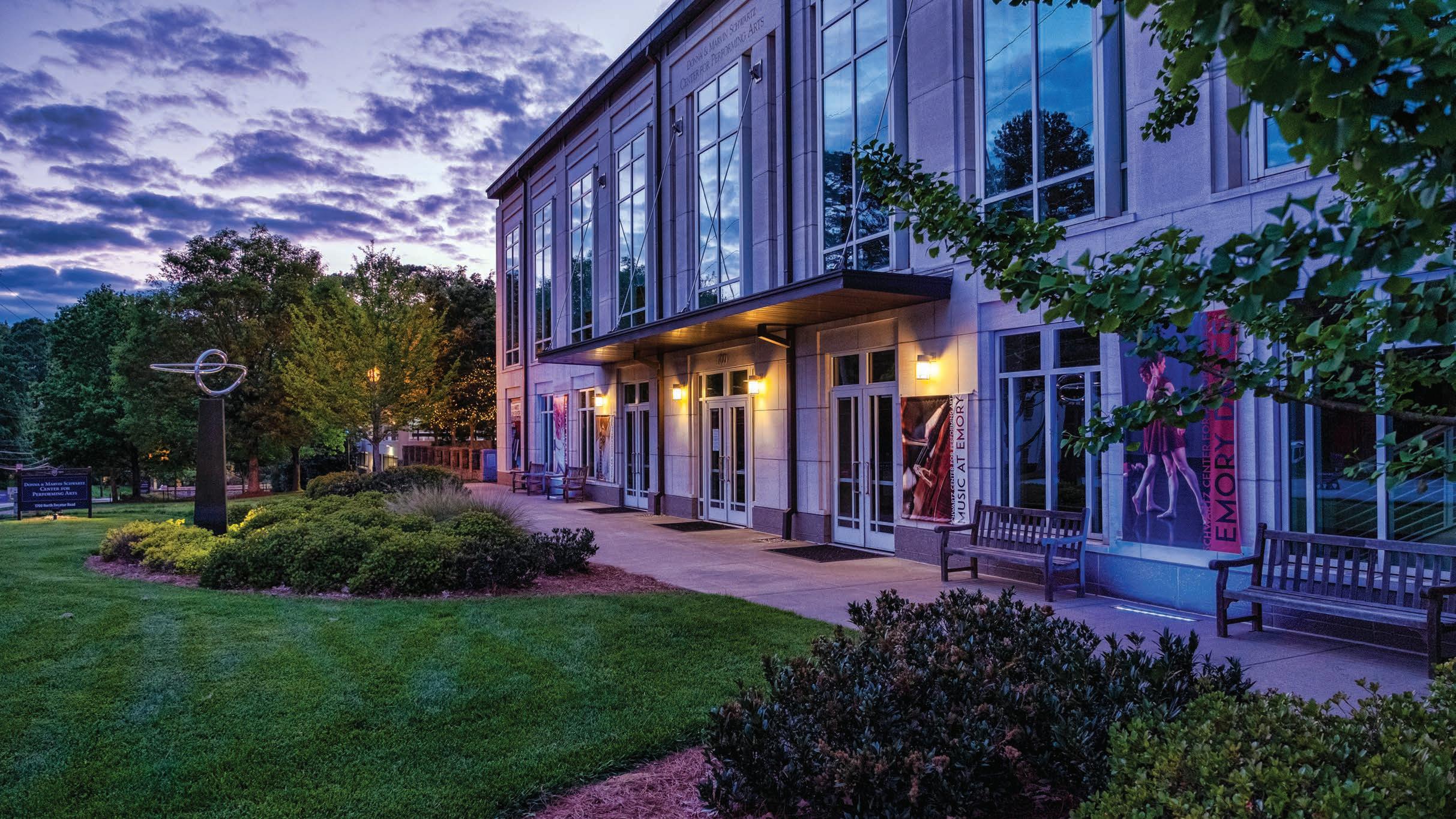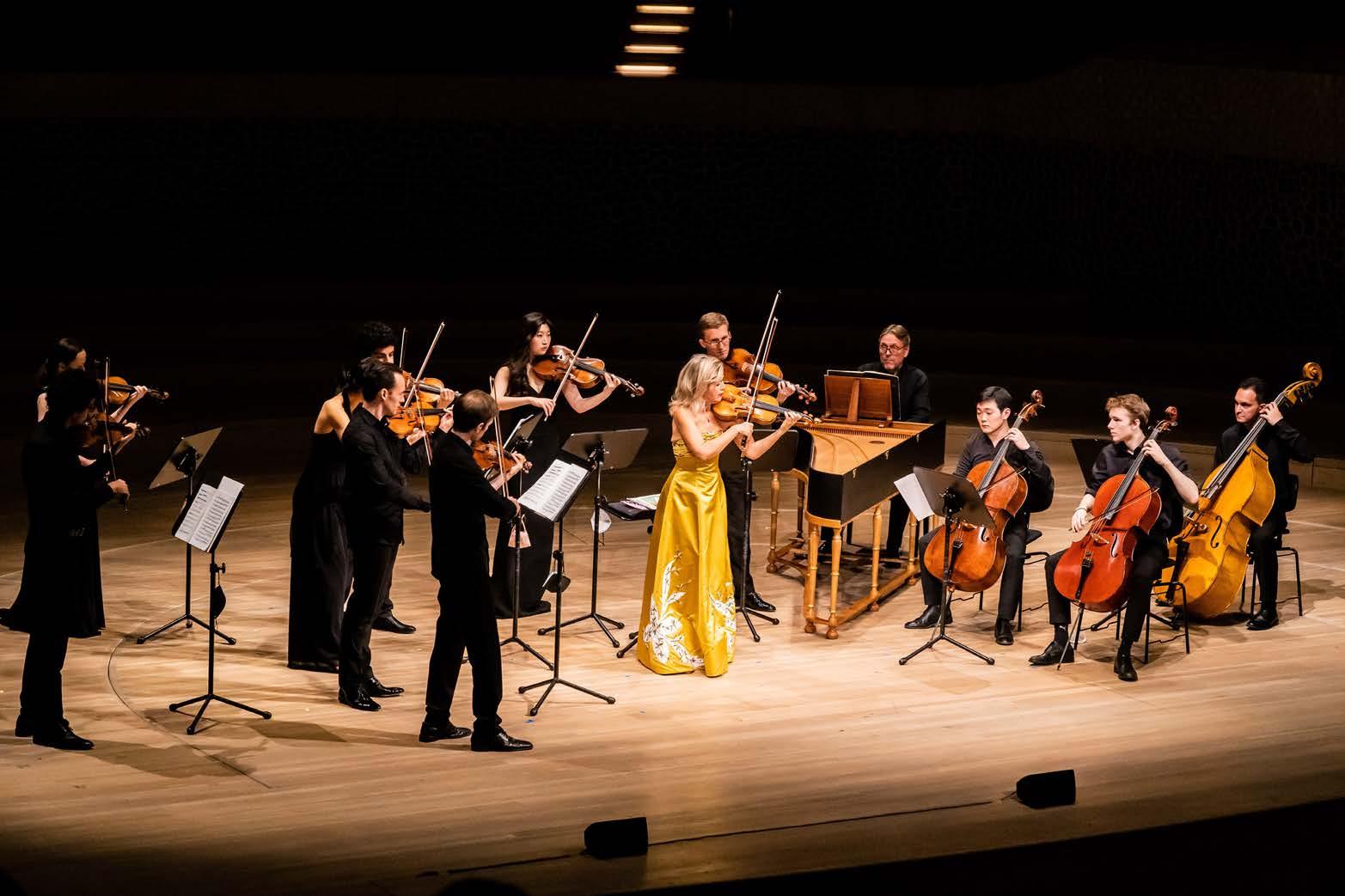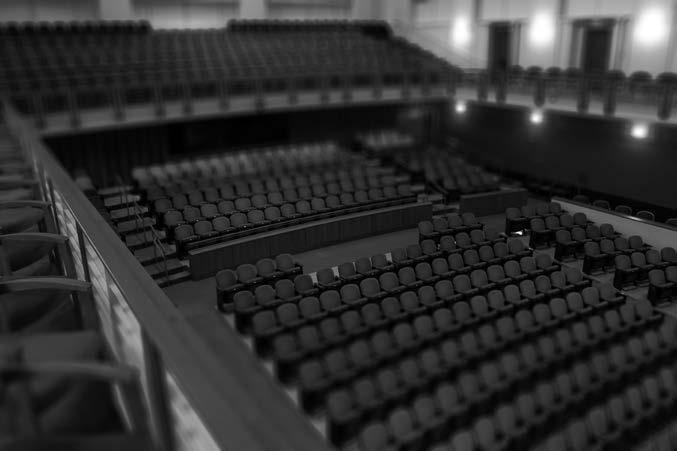Texts and Translations
I. Allegro I. Allegro
Giunt’ è la Primavera e festosetti Springtime has arrived, and merrily la salutan gl’ Augei con lieto canto, the birds salute her with happy songs, e i fonti allo spirar de’ Zeffiretti and at the same time, at the breath of Zephyrus, Con dolce mormorio scorrono intanto. the brooks flow with a gentle murmuring voice. Vengon’ coprendo l’ aer di nero amanto The sk y is covered with a dark mantle and e lampi, e tuoni ad annuntiarla eletti; thunder and lightning are elected to announce her; Indi tacendo questi, gl’ augelletti when they are silenced, the little birds Tornan’ di nuovo al lor canoro incanto. take up their harmonious songs anew.
II. Largo II. Largo
E quindi sul fiorito ameno prato And so, in the meadow, strewn with flowers, al caro mormorio di fronde e piante to the welcome murmuring of leaves and trees, dorme ‘l caprar col fido can’ à lato. the goatherd sleeps, his faithful dog beside him.
III. Allegro III. Allegro
Di pastoral Zampogna al suon festante To a rustic bagpipe, making a festive sound, danzan ninfe e pastor nel tetto amato nymphs and shepherds dance in their favorite spot, di primavera all’ apparir brillante. when springtime appears in its brilliance.
“L’estate” “Summer”
I. Allegro non molto I. Allegro non molto
Sotto dura staggion dal sole accesa Beneath the relentless season heated by the sun, Langue l’ huom, langue ‘l gregge, languishes both man and flock, ed arde il pino; and the pine tree is scorched; scioglie il cucco la voce, e tosto intesa we hear the cuckoo’s voice, and then canta la tortorella e ‘l gardelino. the turtle-dove and the goldfinch sing. Zeffiro dolce spira, mà contesa Sweet Zephyrus blows, but suddenly muove Borea improviso al suo vicino; Boreas joins battle with his neighbor; e piange il pastorel, perche sospesa and the shepherd weeps, because he fears teme fiera borasca, e ‘l suo destino. the dreaded storm overhead, and his destiny.
II. Adagio II. Adagio
Toglie alle membra lasse il suo riposo His tired limbs are robbed of their rest il timore de’ Lampi, e tuoni fieri by fear of lightning and powerful thunder, a de mosche, e mossoni il stuol furioso. as gnats and flies swarm furiously around him.
III. Presto
III. Presto
Ah che pur troppo i suo timor son veri: Alas, his fears are well-founded: tuona e fulmina il ciel e grandioso the sky is filled by dreadful thunder and lightning tronca il capo alle spiche e a’ grani alteri. and hail cuts down all of the tallest crops.
6
“The Four Seasons” from Il cimento dell’armonia e dell’invenzione “La primavera” “Spring”
“L’autunno” “Autumn”
I. Allegro I. Allegro
Celebra il vilanel con balli e canti The peasants celebrate with song and dance del felice raccolto il bel piacere the sweet pleasure of a rich harvest, e del liquor de Bacco accesi tanti and when they are fired by Bacchus’ liquor, finiscono col sonno il lor godere. they finish their celebration with sleep.
II. Adagio molto II. Adagio molto
Fà ch’ ogn’ uno tralasci e balli e canti The singing and dancing are now halted, l’ aria che temperata dà piacere, by the air, now mild, giving pleasure e la staggion ch’ invita tanti e tanti and the season which invites everyone d’ un dolcissimo Sonno al bel godere. to enjoy the sweetest slumber.
III. Allegro III. Allegro
I cacciator alla nov’ alba à caccia At dawn the hunters begin the chase con corni, schioppi, e canni escono fuore; leaving home with horns, guns, and dogs; fugge la belua, e seguono la traccia. the wild beast flees and they track it. Già sbigottita, e lassa al gran rumore, Already terrified, fleeing the great noise se’ Schioppi e canni, ferita minaccia of guns and dogs, it is wounded, feebly languida di fuggir, mà oppressa muore. tries to escape, but finally dies, overwhelmed.
“L’inverno” “Winter”
I. Allegro non molto I. Allegro non molto
Aggiacciato tremar trà neri algenti To shiver, frozen in icy snow, al severo spirar d’ orrido vento. in the severe blasts of a horrible wind. Correr battendo i piedi ogni momento To run while stamping one’s feet constantly, e pel soverchio gel batter i denti. with teeth chattering in the cold.
II. Largo II. Largo
Passar al foco i di quieti e contenti To spend quiet and happy days by the fire, mentre la pioggia fuor bagna ben cento. while rain soaks hundreds outside.
III. Allegro III. Allegro
Caminar sopra ‘l giaccio, e à passo lento To walk on ice, stepping very slowly, Per timor di cader gersene intenti. moving carefully, in fear of falling. Gir forte sdruzziolar, cader à terra To hurry, slip, and fall to the ground. Di nuove ir sopra ‘l giaccio e correr forte To go again over the ice and run energetically sin ch’ il giaccio si rompe, e si disserra. until the ice cracks and breaks open. Sentir uscir dalle ferrate porte To hear, as they leave their iron gates, Sirocco Borea, e tutti i Venti in guerra. Scirocco, Boreas, and all the winds in battle. Quest’é’l verno, má tal, che gioia apporte. This is winter, but it brings joy.
7
—Text attributed to Antonio Vivaldi Edited by J. Michael Allsen
Program Notes
Concerto for Four Violins in B Minor, op. 3, No. 10, RV 580

In the early years of the 18th century, Antonio Vivaldi held the rather modest position of director of a conservatory for homeless girls in Venice, but his compositions were carrying his name throughout Europe. In 1711, he published a collection of 12 violin concertos under the title L’Estro armonico, translated variously as “The Spirit of Harmony” or “Harmonious Inspiration.” Significantly, Vivaldi chose to have this set published in Amsterdam, and for two good reasons: printing techniques there were superior to any available in Italy, and perhaps more importantly, his music was extremely popular in northern Europe. Each of the concertos of L’Estro armonico is a concerto grosso, in which one or more violin soloists is set against a main body of strings and harpsichord continuo. The intent in these concertos is not so much virtuosic display (though they are difficult enough, certainly) as it is in making contrast between the sound of the solo instruments and the main body of strings. The 12 concertos of L’Estro armonico quickly became popular and influential in northern Europe. Bach knew this music very well, and—if imitation is the sincerest form of flattery—paid Vivaldi the immense compliment of transcribing six of these concertos for different instruments and using them as his own (a practice that would be highly questionable today but which was viewed more generously three centuries ago): the present Concerto for Four Violins in B Minor became Bach’s Concerto for Four Claviers in A Minor, BWV 1065. Four of the concertos in L’Estro armonico are for four violins, and of these, the Concerto in B Minor has become the best known. A concerto for four soloists, particularly for four soloists playing the same instrument, is a difficult matter: the composer must find enough for all four to do without burying anyone or allowing the same sonority to become tedious. Vivaldi brings this off with the rapid exchange of passages between soloists, an ingenious contrapuntal texture, and a great deal of rhythmic variety. In the opening Allegro, the main theme is being varied and ornamented almost before it has been completely stated, and Vivaldi quickly has that vigorous main idea leaping between

8
soloists. The slow movement opens with an even slower introduction; the main section has the four soloists playing over quiet continuo accompaniment—Vivaldi assigns an important part of the continuo to a solo cello throughout the concerto. The powerful ritornello that opens the last movement will return throughout; in this movement the soloists play in various combinations with the solo cello as the concerto drives to its close on an energetic tutti.

—Program note © Eric Bromberger. Reprinted with permission.

Gran Cadenza
Gran Cadenza, commissioned by Anne-Sophie Mutter, is a virtuoso duo for two violins. The title alludes to the tradition of virtuoso solo passages in the course of an aria, instrumental concerto, or chamber music piece, traditionally improvised by the soloist or pre-notated by the composer and usually featuring ornamental, rhapsodic, and rhythmically free elements. Cadenzas were originally closely related to a culture of interpretation that included major elements of improvisation and was tolerant of liberal reworking of pieces—a tradition displaced by the new ideals of Werktreue, i.e. faithful execution of the composer’s intention as written, and copyright, which arose in the 19th and at the latest in the 20th century. Gran Cadenza is a complete and fully notated work significantly exceeding the solo cadenza of an instrumental concerto. Still, it reflects elements of free traditional musical forms as might be found in a cadenza, capriccio, or fantasy. The reference to the cadenza is also established via the display of virtuoso abilities by two soloists, which points to the Latin ‘concertare,’ denoting a concert or dispute, but also balance and cooperation. Gran Cadenza relishes in many different forms of interaction—conflict, dialogue, and fusion; its form arises through flowing contrasts and various transitions between these different states. The piece opens with striking and abrupt gestures in the second violin, which are juxtaposed—in total contrast—with ethereal, ornamental figures in the first violin, apparently improvised. After a while the first violin abruptly ‘attacks’ the second, and virtuoso musical battles and skirmishes ensue, with all kinds of fragmented, cadenza-like stock phrases flashing by.
9
Finally, both soloists come together, in sequences of descending chords; the entire kinetic energy comes to a quasi-standstill, merging in triad-like harmonies of alienated sounds, offered in alternation and competition by both violins. This is followed by a sudden surge in energy, including ornamental interjections in which short fragments appear as echoes of earlier motifs or in anticipation of later developments.
After a sudden crescendo, a contrasting middle section offers a lengthy passage of involuntary stasis, in which both violins merge to form a ‘super-instrument.’ The second violin offers a melody that is ornamented with overtones by the first; the tempo gradually increases, with both violins playing different but complementary melodic lines. Time and again, the sequence is interrupted by reminiscences of the piece’s beginning, of striking chords and virtuosic and improvisational fragments; ultimately both lines merge in a quick and dense movement in the middle range, resembling a carpet of sound. This fabric, even if it is interrupted by sudden, flashing fragments, spreads inexorably through various ranges, taking on increasingly virtuosic forms until it is suddenly interrupted by pizzicati and the entire movement comes to an abrupt standstill.
Violin Concerto in A Major, op. 5, No. 2
Joseph Bologne was one of the most versatile figures of the high Classic era. He was born in the Caribbean island of Guadeloupe to a white planter and his African slave Nanon. The father took Nanon and their son with him to France in 1747 for two years, to avoid false charges of murder in Guadeloupe. After the elder Saint-Georges obtained a royal pardon, the three returned to Guadeloupe briefly but moved permanently to France in 1753.
The boy demonstrated unusual athletic talent. He took up fencing at age 13 and rapidly developed formidable skills that earned him a position as a member of the King’s guard in 1764, at age 19. That appointment also carried the title of Chevalier. His personality, legendary swordsmanship, and exotic good looks made him popular with the Parisian nobility, and many contemporary reports refer to his success with the ladies.
Little information survives about Saint-Georges’s early musical training, but some dedications to him of works by the composer FrançoisJoseph Gossec and the Italian violinist and composer Antonio Lolli indicate he likely studied with both of them. We do know that he joined Gossec’s orchestra in 1769 and was soon promoted to be its concertmaster. He began performing as a soloist in the 1770s, including performances of
10
—Program note © Maris Gothoni. Translation: Alexa Nieschlag
his own concertos. Those works attest to his superior technique, and to the advantage he found in the newly developed Tourte bow. By the mid1770s, Saint-Georges was directing the Concert des Amateurs, which was soon acknowledged to be one of Europe’s finest orchestras.
Most of Bologne’s published works were issued in Paris between 1772 and 1779. They consist of three types: string quartets, symphonies concertantes (featuring more than one soloist), and violin concertos. This concerto in A major appeared in 1775, with another concerto in C major, as Saint-Georges’s op. 5. The publisher was Antoine Bailleux, who published works by Italian and Austrian masters as well as other French composers in the emerging classical style.
By 1775, Bologne’s mentor François-Joseph Gossec had left the Concert des Amateurs to assume the directorship of the Concert Spirituel. The Chevalier assumed the leadership of the Concert des Amateurs and almost certainly performed both of his op. 5 concertos with that ensemble—his debut with them as a soloist in 1772 is documented.
To 21st-century listeners, this music will sound a great deal like Mozart, but it is far more likely that Mozart was influenced by the Chevalier than the reverse. The prodigiously gifted Austrian was more than a decade younger and was conversant with musical trends in Italy and France as well as his native Austria. We know that Mozart met Saint-Georges in Paris in 1778, during the fateful trip when Mozart’s mother died.
The A-major concerto is a substantial, large-scale work; its opening Allegro moderato alone takes about 12 minutes in performance. The work is in concerto-sonata form, with a full orchestral exposition preceding the soloist’s entrance. Phrases are well-balanced, and the string writing is deftly handled. The soloist introduces a new theme, supported only by the orchestral violins. That lighter texture—a holdover from the concerto grosso idea—holds for solo passages throughout the concerto. SaintGeorges reserves his cadenza for the lyrical slow movement, a Largo in D major. Once again, an extensive string introduction precedes the solo entrance. Steady triplets give the movement the lilting feel of 12/8 time. Placement of the cadenza in this Largo suggests that Saint-Georges felt more at home improvising in a lyrical vein.
That stated, he leaves no doubt about his virtuoso credentials. Almost all of the concerto favors high register, with abundant string crossings and double-stopped passages. In the finale, a Rondeau, the soloist and orchestral violins present the catchy, dance-like theme before full orchestra echoes it. Of the three episodes interpolated between rondeau statements, the middle one in A minor is the most interesting, with irregular six-bar phrases, a musette-like drone, and a brief sideways
11
excursion into C major. The final episode boasts dazzling arpeggiation and other eye-popping bravura passages that seem to presage the era of Niccolò Paganini.
—Program note ©2022 Laurie Shulman. Reprinted with permission.
“The Four Seasons,” op. 8, Nos. 1–4, from Il cimento dell’armonia e dell’invenzione
Antonio Vivaldi took after his father in playing the violin, but “The Red Priest,” as the ginger-haired composer came to be called, trained for a life in the church instead of studying music. Ordained in 1703, Vivaldi took a job at a school for orphaned girls in Venice, where he taught them violin and, for a time, also performed mass. He was known in his day as a top-notch violinist, with less attention paid to his many compositions, spanning chamber music, opera, sacred music, and of course his concertos—more than 500 total, with at least 230 featuring the violin. Vivaldi developed or codified some of the most important aspects of concerto style, such as the fast-slow-fast sequence of movements and the use of ritornello structure as a way to differentiate sections for the soloist and full ensemble. Much of Vivaldi’s influence lives on through the work of one of his greatest admirers, J. S. Bach—just seven years younger but deeply influenced by the Italian’s published scores. The styles of the two masters are so intertwined that certain scores in Bach’s own handwriting, long thought to be original compositions, proved to be transcriptions from Vivaldi works.
In 1725, Vivaldi published a set of 12 concertos under the title Il cimento dell’armonia e dell’invenzione (The Contest Between Harmony and Invention). He named the first four concertos after the seasons, and based the scores on descriptive sonnets, which he likely wrote himself. The poems provided ample opportunities for word painting, as in the “birds in joyous song” in the first movement of “Spring,” represented by trilling violin motives, countered later by thunder and lightning. The docile slow movement depicts a goat-herd napping in a meadow, with the violas assigned the part of his barking dog. The finale depicts nymphs and shepherds dancing to bagpipes—a sound evoked in the droning accompaniments. “Summer” brings the “heat of the burning sun,” matched by wilting musical figures. The soloist enters in the style of a cuckoo, with the distinctive two-note call embedded within constant bow-strokes. The arrival of a stiff wind from the north, bringing a squall, sends the movement into an agitated state. The slow movement depicts another nap, this one interrupted by the nuisance of gnats and flies and occasional
12
peals of thunder. The finale unleashes the full force of the summer storm, the lines cascading down like sheets of rain.
“Autumn” begins with peasants dancing and drinking in celebration of the harvest until they all settle into an inebriated slumber. The slow movement descends into the soundest sleep yet, with the soloist joining the muted strings in slow-moving phrases, leaving only the harpsichord to decorate the harmonies with ad libitum arpeggios. The finale wakes for a hunt, complete with imitations of hunting horns and barking dogs.
“Winter” paints a scene of desolate cold, with snow blowing in the wind and teeth chattering. The slow movement moves the scene to a cozy fire inside, while pizzicato raindrops continue to fall outside. The finale starts with hesitant, slippery steps on the ice and builds to gusts of raging winds. —Program note ©2014 Aaron Grad. Reprinted with permission.
Performer Biographies
Anne-Sophie Mutter
Violinist Anne-Sophie Mutter is a musical phenomenon: for 47 years, the virtuoso has been a fixture in the world’s major concert halls, making her mark on the world as a soloist, mentor, collaborator, humanitarian, and visionary artist.
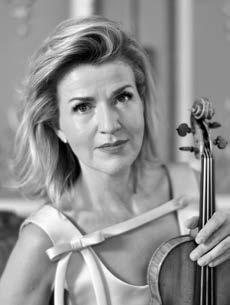
A prolific recording artist with four Grammy Awards, Mutter is equally committed to the performance of the traditional violin catalog and to the expansion of the repertoire. To date, she has given world premieres of 31 works written for her by such distinguished composers as Thomas Adès, Unsuk Chin, Sebastian Currier, Henri Dutilleux, Sofia Gubaidulina, Witold Lutosławski, Norbert Moret, Krzysztof Penderecki, Sir André Previn, Wolfgang Rihm, Jörg Widmann, and John Williams, among others.
Dedicated to supporting tomorrow’s musical elite, Mutter founded the Association of Friends of the Anne-Sophie Mutter Foundation in 1997, to which the Anne-Sophie Mutter Foundation was added in 2008. These two charitable institutions provide support for the foundation’s scholarship recipients, which is tailored to each of the fellow’s individual needs. Since 2011, Mutter has regularly shared the spotlight on stage with her ensemble of fellows known as Mutter Virtuosi.
13
© THE JAPAN ART ASSOCIATION / THE SANKEI SHIMBUN (2019)
In the year she turns 60, Mutter’s 2023 concerts reflect both her versatility and her peerless rank in the classical music world. Numerous compositions dedicated to her fill her calendar; in many countries, these works will be programmed for the first time. At the turn of the new year, Anne-Sophie Mutter and the Mutter Virtuosi tour Iceland, the United States, and Canada. Two further tours in summer take Mutter and her Virtuosi through Europe.
In the United States, with the Boston Symphony Orchestra under Andris Nelsons, she performs Thomas Adès’s Air—Homage to Sibelius, a work she co-commissioned and premiered at the Lucerne Festival in 2022 together with the composer.
A European chamber music tour in May/June will feature Mutter with pianist Lambert Orkis and cellist Maximilian Hornung performing Brahms’s Sonata No. 3 in D Minor, op. 108; Clara Schumann’s Three Romances, op. 22; Beethoven’s “Ghost Trio,” and the European premiere of Sebastian Currier’s Ghost Trio (dedicated to Mutter).
Another musical focus in 2023 is the work of John Williams. Mutter will perform his Violin Concerto No. 2, dedicated to her, as well as a selection of the virtuoso adaptations of film scores Williams created especially for her in Australia, Europe, and the United States—the American performances conducted by the composer himself.
She concludes her 60th birthday year performing Krzysztof Penderecki’s Violin Concerto No. 2 “Metamorphosen”(dedicated to Mutter) in honor of the 90th birthday of the composer, who passed away in 2020. She will play this work in Poland and Israel together with the Warsaw National Philharmonic Orchestra under Andrey Boreyko.
Anne-Sophie Mutter has been awarded the German Grand Order of Merit, the French Medal of the Legion of Honor, the Bavarian Order of Merit, the Decoration of Honor for Services to the Republic of Austria, and numerous other honors. Most recently, the Krzysztof Penderecki Academy of Music in Krakow bestowed an honorary doctorate upon her (March 2022), and she has been recognized around the world for her contribution to the arts, culture, social causes, and leadership.
The Mutter Virtuosi
Established in 2008 by renowned violinist Anne-Sophie Mutter, the AnneSophie Mutter Foundation supports a select number of young, highly talented string players who receive scholarships through the foundation

14
© Ansgar Klostermann
to study their craft at the highest artistic level. Their time as scholarship students includes mentorship and training with Mutter herself, as well as coaching, financial support, and performance opportunities on world stages. Some of today’s most prominent artists—including violinists Sergey Khachatryan, Daniel Müller-Schott, and Arabella Steinbacher, and bassist Roman Patkoló—received scholarships and support from the Anne-Sophie Mutter Foundation.
Each student is selected personally by Mutter, who designs individual scholarship support to meet each recipient’s unique needs, such as the selection of a suitable teacher, the provision of instruments, establishing meetings with soloists and participation in their master classes, or arranging auditions with conductors. Mutter firmly believes that “instead of setting fixed and inflexible rules, I am more concerned with giving every student what he or she needs.” This ethos has served her program well, and her support of these early-career promising artists has proven invaluable to the recipients of the scholarships, who now total 24, with nine current students from the United States, Europe, and Asia.
In 2011, Mutter founded the Mutter Virtuosi, an ensemble of the foundation’s former and current scholarship students with whom she performs regular concerts with the dual purpose of introducing them to the life of a professional musician, while simultaneously introducing them to a broad audience as part of their career building. The foundation regularly commissions new music for the ensemble, ensuring that the young artists understand their responsibility to perform music written by composers of today. To date, Mutter and the Virtuosi have given the world premiere of commissioned works by André Previn—Concerto for violin, contrabass, and orchestra and Nonet for two string quartets and double bass; Wolfgang Rihm—Dyade; Sebastian Currier—Ringtone Variations; Krzysztof Penderecki—Double Concerto for violin and contrabass; and Unsuk Chin—Gran Cadenza for two violins.
Along with creating the Virtuosi in 2011, the foundation also created the Aida Stucki Award, which honors outstanding young professional string soloists who follow the strong tradition of Stucki’s and the European tradition of performance and education. The prize is named for the legendary Swiss violinist and teacher of Mutter, who chose to honor her because “Aida Stucki is my guiding star in every respect—an incomparable violinist, a noble human being, and a fantastic woman.” The prize, which carries a cash value of 10,000 Euros and is given at the discretion of the foundation, has been awarded to double bassist Roman Patkoló and cellist Daniel Müller-Schott.
15
Mutter and the Virtuosi toured together for the first time in 2011, to 11 European cities, followed in 2013 by a seven-city tour in Asia, and a United States and Canada tour in 2014, which included the ensemble’s debut at the legendary Carnegie Hall. They have toured the world together regularly during the past decade, including South America, and embark on their eighth tour in 2023 to Iceland, Canada, and the United States, with a program of music by Vivaldi, Unsuk Chin, and Joseph Bologne, Chevalier de Saint-Georges.
Samuel Nebyu, soloist (Unsuk Chin)
Ethiopian-Hungarian violinist Samuel Nebyu has performed as a soloist at international music festivals and venues such as the Musikverein, Berlin Philharmonie Concert Hall, KKL in Lucerne, Carnegie Hall, and Alice Tully Hall in New York, the Walt Disney Concert Hall in Los Angeles, the Wallis Annenberg Center in Beverly Hills, Verizon Hall and Perelman Theater in Philadelphia, Abravanel Hall in Salt Lake City, the Centre of Performing Arts in Brussels (BOZAR), Peles Castle in Romania, the Wiener Saal and Grosse Saal in Salzburg, Tel Aviv Museum of Arts, Crown Hall in Jerusalem, Teatro Colon in Buenos Aires, Teatro Mayor in Colombia, Gran Teatro Nacional in Peru, and Astana Central Concert Hall in Kazakhstan. Nebyu’s first CD, Music by Composers of African Descent, was released on the BCM+D label and was named Album of the Week by WRTI radio in Philadelphia and WQXR in New York. Nebyu is featured on a second CD, Majestic Classics, where he performed Mozart’s Sinfonia Concertante with the iPalpiti Chamber Orchestra and violist Juan Miguel Hernandez. In 2019, he was the featured soloist at the Kimmel Center Verizon Hall in Philadelphia, performing the “Singing Rooms” Violin Concerto with Choir and Orchestra composed by Jennifer Higdon, and also gave a recital with pianist Lambert Orkis in Rock Hall, Philadelphia.
Nebyu received a commendation from the city of Los Angeles after his performance at the Walt Disney Hall in 2019. In October 2019, Nebyu joined the Mutter Virtuosi on their sixth tour in South America. He performed Mendelssohn’s Octet and Bach’s Concerto for Two Violins with Anne-Sophie Mutter. In fall 2021, he joined Mutter and Mutter Virtuosi on a month-long European tour with 19 performances. He recently performed at the Lucerne Festival in Switzerland, with pianist Charles Abramovic, in his debut recital of composers of color, which included a premiere of a piece written for Nebyu titled Grey Fireworks by composer Tyson Davis.
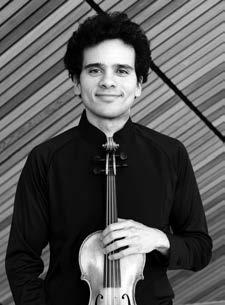
16
© Michael Shingo
Crawford
Upcoming Emory Music Concerts
Many spring music events at Emory are free to attend. Visit music.emory. edu or schwartz.emory.edu to view descriptions and information for upcoming music events. If an event requires a ticket for attendance, prices are indicated in the listings below in the following order: Full price/Emory student price (unless otherwise noted as the price for all students).
Friday, February 3, 7:00 p.m., Pajama Concert: Musical Bedtime Stories, ECMSA: Family Series, Carlos Museum, free Saturday, February 4, 8:00 p.m., Maria Clark, soprano, Artist Affiliate Recital, Schwartz Center, Emerson Concert Hall, free
Friday, February 10, 8:00 p.m., Emory Jazz Fest 2023, Warren Wolf and the Emory Jazz Fest All-Stars, Schwartz Artist-in-Residence Program, Schwartz Center, Emerson Concert Hall, $30/$10, tickets required Saturday, February 11, 8:00 p.m., Emory Jazz Fest 2023, Emory Big Band with the Gary Motley Trio and members of the Emory University Symphony Orchestra, Schwartz Center, Emerson Concert Hall, free, tickets required
Sunday, February 12, 4:00 p.m., The Bach Bowl: A Very Varied Goldberg Variations, ECMSA: Emerson Series, Schwartz Center, Emerson Concert Hall, free Saturday, February 18, 8:00 p.m., Friends and Mentors, ECMSA: Emerson Series, Schwartz Center, Emerson Concert Hall, free
Wednesday, February 22, 8:00 p.m., Emory Youth Symphony Orchestra, Schwartz Center, Emerson Concert Hall, free Friday, February 24, noon, Vivaldi’s Four Seasons, ECMSA: Cooke Noontime Series, Schwartz Center, Emerson Concert Hall, free
Saturday, February 25, 8:00 p.m., Emory University Symphony Orchestra with Elisabeth Remy Johnson, harp, and the Vega Quartet, Schwartz Center, Emerson Concert Hall, free
Sunday, February 26, 4:00 p.m., Emory Wind Ensemble, Schwartz Center, Emerson Concert Hall, free
19
